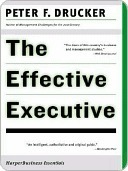More on this book
Community
Kindle Notes & Highlights
For a fact, after all, is an event which somebody has defined, has classified and, above all, has endowed with relevance.
What all these effective executives have in common is the practices that make effective whatever they have and whatever they are.
“What should we at the head of this organization know about your work? What do you want to tell me regarding this organization? Where do you see opportunities we do not exploit? Where do you see dangers to which we are still blind? And, all together, what do you want to know from me about the organization?” This leisurely exchange is needed
The first step toward executive effectiveness is therefore to record actual time-use.
But above all, meetings have to be the exception rather than the
The final step in time management is therefore to consolidate the time that record and analysis show as normally available and under the executive’s control.
And all effective executives control their time management perpetually. They not only keep a continuing log and analyze it periodically. They set themselves deadlines for the important activities, based on their judgment of their discretionary time.
But the man who focuses on contribution and who takes responsibility for results, no matter how junior, is in the most literal sense of the phrase, “top management.
For every organization needs performance in three major areas: It needs direct results; building of values and their reaffirmation; and building and developing people for tomorrow.
Executives in an organization do not have good human relations because they have a “talent for people.” They have good human relations because they focus on contribution in their own work and in their relationships with
It is its capacity to make common people achieve uncommon performance.
Organization must serve the individual to achieve through his strengths and regardless of his limitations and weaknesses.
Most executives have learned that what one postpones, one actually abandons.
The clear realization that the problem was generic and could only be solved through a decision which established a rule, a principle; 2. The definition of the specifications which the answer to the problem had to satisfy, that is, of the “boundary conditions”; 3. The thinking through what is “right,” that is, the solution which will fully satisfy the specifications before attention is given to the compromises, adaptations, and concessions needed to make the decision acceptable; 4. The building into the decision of the action to carry it out; 5. The “feedback” which tests the validity and
...more
“Does the explanation explain the observed events and does it explain all of them?; he always writes out what the solution is expected to make happen—make automobile accidents disappear, for instance—and then tests regularly to see if this really happens; and finally, he goes back and thinks the problem through again when he sees something atypical, when he finds phenomena his explanation does not really explain, or when the course of events deviates, even in details, from his expectations.
“What is the minimum needed to resolve this problem?”
The first step toward effectiveness is a procedure: recording where the time goes.
The next step, however, in which the executive is asked to focus his vision on contribution advances from the procedural to the conceptual, from mechanics to analysis, and from efficiencies to concern with results.
Making strengths productive is fundamentally an attitude expressed in behavior.
Chapter 5, “First Things First,” serves as antiphon to the earlier chapter, “Know Thy Time.” These two chapters might be called the twin pillars between which executive effectiveness is suspended and on which it rests. But the procedure here no longer deals with a resource, time, but with the end product, the performance of organization and executive. What is being recorded and analyzed is no longer what happens to us but what we should try to make happen in the environment around us. And what is being developed here is not information, but character: foresight, self-reliance, courage. What is
...more
The effective decision, which the final chapters discuss, is concerned with rational action.


